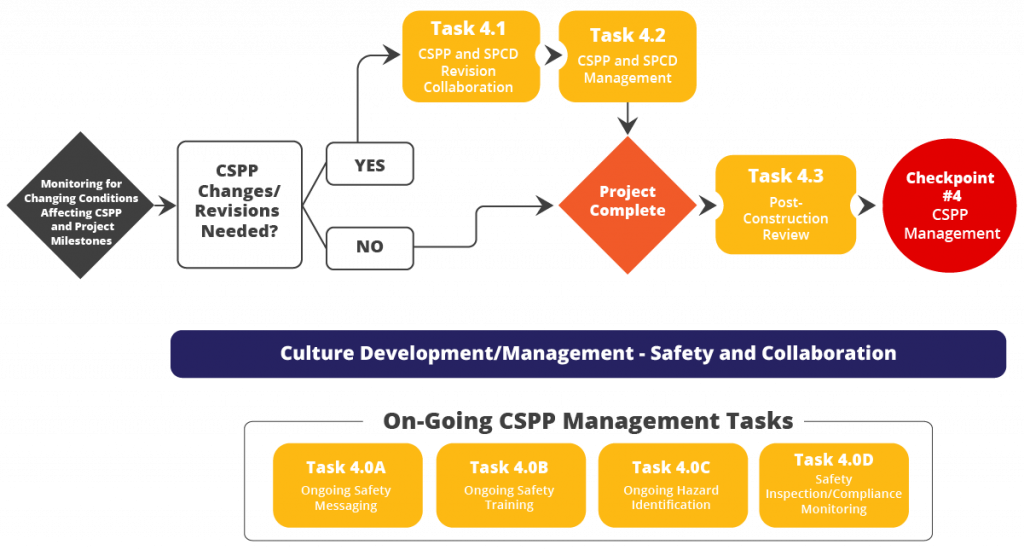Phase 4: CSPP Management Phase
The graphic below identifies the tasks that are part of Phase 4: CSPP Management Phase. A description of each task, checkpoint, and the focus of the safety/collaboration efforts associated with this phase can be accessed by clicking on the graphic below.

You can move to the previous phase of the construction safety and phasing plan (CSPP) process using the following link – Previous Phase. You can also navigate to any phase using the CSPP Process drop-down tab at the top of the page.
Tools
Below is a list of tools, templates, and training materials applicable to this phase. Each of these items can be downloaded and customized based on the airport and project. Please note that some tools may appear in multiple phases of the CSPP process as some tools are applicable to multiple phases.
Construction Daily Inspection Checklist
CSPP Process Checkpoints Checklists
Contractor Training Guide (CTG)
Best Practices/Lessons Learned
As part of ACRP Project 08-03, a number of best practices/lessons learned (BP/LL) were identified for the CSPP Management Phase. Please note that some BP/LL may appear in multiple phases of the CSPP process as some BP/LL are applicable to multiple phases.
The BP/LL identified for this phase are listed below:
Standardized Inspection Procedures: Standardized checklists and inspection procedures should be established to ensure proper compliance with the CSPP throughout the construction effort. The procedures should include clear lines of responsibility for who will do the inspections and when various inspections should be conducted. The procedures should also include consideration for “unannounced” inspections and more detailed safety “audits.” Safety audits are in-depth inspections to verify compliance with safety procedures.
Power Vacuum and Sweeper Truck Availability: If any portion of a construction project (e.g., typically a haul route) is going to cross an active portion of the airfield, a power vacuum/sweeper vehicle should be on stand-by anytime construction activities are in progress. This will ensure that any foreign object debris (FOD) from the construction operation can be quickly removed. The power vacuum/sweeper vehicle should be equipped with poly bristles. Metal bristles should not be utilized as they can fall off and create additional FOD. If the construction project is at an airport with a low traffic volume, someone should inspect and sweep the active portion of the airfield anytime a construction vehicle uses the area.
“Dry-Run” Simulations for Very Complex Projects: For some very complex or time-sensitive phases of a project, a “dry-run” simulation of the phase should be conducted prior to the actual work beginning to ensure that everybody knows their roles and responsibilities and any potential issues can be identified ahead of time. This “dry-run” could include a review of staging areas, haul routes, access procedures, construction boundaries, and other items critical to the safety of the project. Dry-runs can also improve familiarity when moving from daytime to nighttime work.
Post-Construction Reviews: After a construction project is completed, a meeting should be held that involves the key project stakeholders to discuss what went well and what did not go well from a construction safety and phasing perspective. These meetings are sometimes called a “hot wash” or “after-action review.” The meeting should also be utilized to identify ways CSPP practices can be improved for future projects. For large complex projects, these meetings may be held at the conclusion of a major phase. This best practice has been integrated into the CSPP process developed as part of this research effort.
Complete Full CSPP Review Anytime Phasing is Changed: A full review of the entire contents of a CSPP and safety plan compliance document (SPCD) should be completed by the airport, consulting engineer/designer, contractor, and other key stakeholders anytime a significant change is made to the original phasing of the project or at the conclusion/beginning of a phase. Doing a full review will help identify any other elements of the CSPP that need to be changed based on the change to the project’s phasing.
Engage Air Traffic Control Tower and FAA Technical Operations Throughout the Development, Implementation, and Management of a CSPP: For airports with Air Traffic Control Tower (ATCT) facilities and/or FAA-owned navigational aids (NAVAIDs), local ATCT and FAA Technical Operations (TechOPS) personnel need to be consulted in the development of the CSPP and any revisions that are made. This should include participating in CSPP review meetings during CSPP development and ongoing construction progress meetings when construction is underway. If the airport creates a standing construction exploratory committee, local ATCT and FAA TechOPS should be part of the committee.
Planning for Phase Changes During Construction: While a construction project is underway, the contractor should develop communication/education strategies to ensure their staff are aware of any changes associated with the start of a new construction phase (e.g. changing haul routes, protected areas). This communication should be carefully coordinated with the airport sponsor and consulting engineer/designer.
Visual Cues to Prevent Utilization of Previous Haul Routes: When the use of a haul route is discontinued, visual cues should be provided to make sure drivers know the haul route is no longer active. Visual cues may include the use of barricades, signage, and/or flaggers at the entrance to the discontinued haul route.